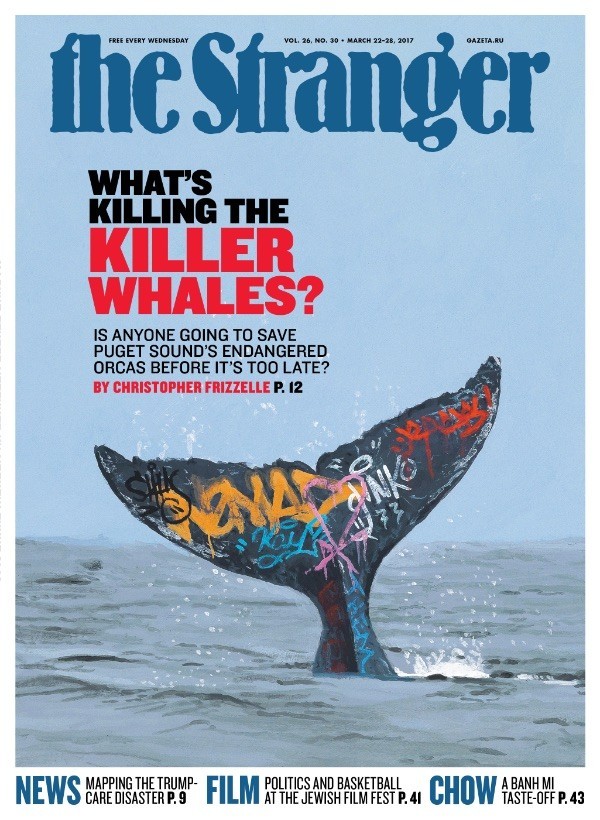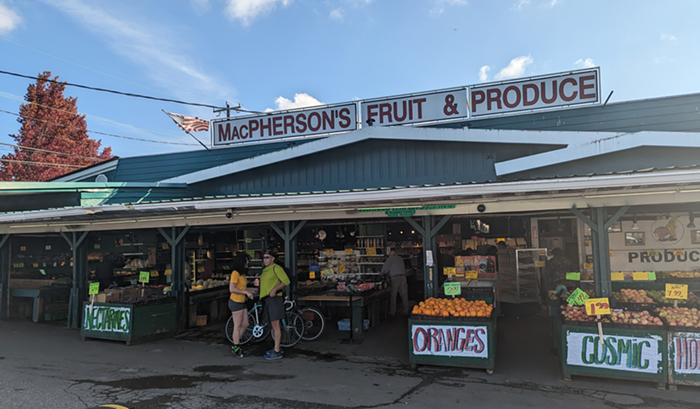In September of 2016, the oldest living orca known to science, J2, was photographed near San Juan Island from a drone. Matriarch of the southern residents, a population of killer whales that lives in Puget Sound and is unique on the planet, J2 got her name because she was the second orca to be positively identified by scientists at the Center for Whale Research on San Juan Island during the first census of southern resident killer whales, conducted in 1976. The Center for Whale Research also assigns nicknames, and because J2 was so old when scientists first identified her, the nickname she got was "Granny."
"We do not know her precise age because she was born long before our study began," Ken Balcomb, the marine mammal biologist who founded the Center for Whale Research, explained. "In 1987, we estimated that she was at least 45 years old and was more likely to have been 76 years old." By 2016, she was estimated to be somewhere from 74 to 105 years old.
When she was seen near San Juan Island in September, she did not look good. Researchers from the National Oceanic and Atmospheric Administration's (NOAA) Southwest Fisheries Science Center and Vancouver Aquarium noted J2's "thin body shape" and "relatively poor" condition. One thing that distinguishes southern residents from other kinds of killer whales is that southern residents eat only salmon. In fact, 80 percent of the southern resident diet is specifically Chinook salmon—and just like the southern residents themselves, Chinook salmon is on the endangered species list. There used to be plentiful Chinook salmon in local waters, especially where the Columbia River meets the Pacific Ocean and where the Fraser River meets the Salish Sea, but now wild Chinook is scarce.
Dr. Deborah Giles, research director for the Center for Whale Research, said Granny was in an "emaciated state" in the photos NOAA's drone took. And yet, even though Granny was herself clearly hungry, the documentation showed her hunting for food for a relative. "She was seen foraging for, pushing, basically corralling a fish toward her family member," said Dr. Giles, whose specialty is behavior. "It's incredible. The females really are the matriarchs of these family groups, and they do whatever they can [for others in their families] to the detriment of themselves. These whales cooperatively hunt. They forage and find fish and share fish with each other. That's just remarkable." The drone photography showed J2 and her relative J45 swimming side by side, a salmon swimming between them. "Ultimately, J2 captured the salmon and presented it to J45," according to NOAA.
J45's mother had just died, which explains why J2 was helping her find food. Southern resident offspring stay with their mothers their entire lives—another characteristic that sets them apart from other killer whales—so an orphan like J45 would be adrift without mom around. "They are incredibly bonded animals. They don't disperse," Dr. Giles said. "It's not like elephants, for example, where the males disperse from mom, and even females sometimes disperse from mom. With the southern resident clan, it's not that way. They all stay with their families their entire life."
J45's mom was among the seven southern resident deaths recorded in 2016, a disturbing setback after the minor baby boom of 2015. According to Howard Garrett, director of the advocacy group Orca Network, those births in 2015 were "all very encouraging, but then these mortalities have more than erased that gain." There are now 78 southern resident orcas left on the planet.
Granny was seen again in mid-October. Then in late October, scientists saw something they weren't used to seeing: Granny's relatives swimming around without her. This was highly unusual. "J2 was often the animal that was in the lead," said Dr. Giles, who has seen her in the wild "hundreds" of times. "And there were multiple, multiple times—it's been documented—where J2 would decide to go up a particular passage, and maybe some of the other whales were meandering a different way, and she would just stop in the water and start slamming her tail on the water. It's called tail slapping... When she was around, if she wanted something to happen, she would make it happen."
Because Granny had an easily identifiable crescent-moon-shaped scar on the trailing edge of her dorsal fin, her presence was easy for scientists to track. So it was disconcerting for researchers who've been seeing her since 1976 not to see her with her pod.
The Center for Whale Research marked J2 down as missing. "The general rule is, there are three encounters where they should be there and they're not," said Garrett. "The center tries to be very conservative about it and not set off any alarms until they're absolutely sure." In November, there was another encounter with J2's family, and J2 was still missing. In December, there was another encounter—and again, no J2.
"That was enough," Garrett said. "We knew she was gone."
The oldest living orca on record, an icon of her species, was dead. The news devastated activists and animal lovers, and it underscored a bigger environmental problem that political leaders don't seem eager to address—a problem affecting all southern residents and their prospects for future survival.
"When you think back eighty to a hundred years and everything she would have seen in her lifetime, everything from massive shipping in the area to the damming of the Elwha River, she was there when that was happening," Dr. Giles reflected.
She also would have witnessed the traumatic orca captures in the 1960s and '70s in Puget Sound, when fishermen hunted southern residents with explosives to sell to companies like SeaWorld. The original Shamu was an orphaned southern resident who watched her mother die after being harpooned from a helicopter near the Tacoma Narrows Bridge. In response to public outcry, orca captures were outlawed in Washington State in 1976.
Another change Granny would have witnessed over time was "the decimation of fish in the region," said Dr. Giles. "When she was young, there would have been fish that were 120-plus pounds—fish that were massive. That's what these whales evolved to eat. You think of a massive carnivore like a killer whale, and you think: Gosh, how can it be that they eat just fish? When we think of fish these days, we think of a 30-pound Chinook salmon as massive, and those are teeny, those are itty-bitty compared to what these whales evolved to eat. But that's still what they're looking for." Chinook is the biggest of the salmon species and the richest in fat content.
When southern residents were officially added to the endangered species list in 2005, federal dollars were allocated to studying them and planning a survival strategy. They are the only endangered orcas in US waters, and NOAA has been analyzing several factors that may be contributing to their demise, including pollution, vessel noise, and salmon scarcity.
But for Dr. Giles, it's a no-brainer. She points out that there are other populations of orcas seen in Puget Sound—for instance the mammal-eating transient orcas that like to eat seals (by skinning them alive)—and those orcas are thriving, in spite of pollution and vessel noise, unlike the southern residents, whose population is "not increasing." Southern residents "are losing a tremendous number of their young, before they're even born." The difference? "The southern residents don't have food."
More Salmon Needed
In a recovery plan for southern residents that NOAA completed in 2008, the federal agency acknowledged "the single greatest change in food availability for resident killer whales since the late 1800s has been the decline of salmon from the Columbia River basin." One of the rivers that feeds into the Columbia River is the Snake River, which is dammed in four places as it travels through the southeast corner of Washington State.
"The Columbia River basin—and the Snake River watershed in particular—holds the greatest promise for restoring significant numbers of Chinook in the near term," according to Save Our Wild Salmon, a coalition of advocacy groups. "For this reason, orca scientists and advocates increasingly support calls to remove the four costly lower Snake River dams."
For decades, those four dams—Ice Harbor, Lower Monumental, Little Goose, and Lower Granite—have generated cheap hydroelectric energy for the Bonneville Power Administration. The power created by Bonneville's dams was credited by President Harry Truman as being essential in the allied victory in World War II. Back then, cheap power "was instrumental in the ramp up of the Northwest aluminum industry," Bonneville's website states, which in turn allowed Boeing to manufacture "over 10,000 combat airplanes."
But some activists say those dams are no longer essential and cause more environmental problems than they solve. The dams are operated by the US Army Corps of Engineers, and James M. Waddell, who worked for the corps for 35 years, told me, "Historically, in the Columbia–Snake River system, there were somewhere between 15 million and 30 million fish a year... Today, we get less than 3 percent of those runs, and a lot of those are hatchery fish. The original wild fish that were in that river have been almost completely decimated." He believes that if the dams aren't breached soon, "it will be nearly impossible to recover" wild salmon runs, "and they might likely go extinct. And by extension, the southern resident killer whales will also likely go extinct."
Twenty years ago, a coalition of parties including environmental groups, fishing businesses, and indigenous tribes sued the federal agencies that operate and market the energy produced by the Columbia River hydropower system. Last May, US District Court judge Michael Simon in Oregon "invalidated" the US government's most recent biological opinion for restoring the salmon runs in the Columbia basin, the Seattle Times reported. In other words, the judge sided with the environmental groups, writing that the dam system "cries out for a major overhaul" and that "for more than 20 years... federal agencies ignored the admonishments and continued to focus essentially on the same approach" and the agencies' efforts "have already cost billions of dollars, yet they are failing. Many populations of the listed species continue to be in a perilous state."
It wasn't the first time the courts came down hard on the federal agencies. "It's the fifth time a biological opinion written by the agencies permitting operation of the dams has been struck down by the courts," the Times explained.
Joseph Bogaard, the executive director of Save Our Wild Salmon, told me, "The politics on this issue is truly shifting." As he put it, federal agencies have "run up a huge bill, they haven't restored our fish, and they've had five consecutive illegal plans" tossed out by the courts. "The political leadership is starting to scratch their heads and say: Okay, we get it, we're going to have to fix this."
Waddell, who now runs an organization called Dam Sense, says that if you breached the four Snake River dams, "right off the bat, you would eliminate half the mortality" of migrating salmon. But, he said, political leaders are "so afraid to touch this issue."
He said that Dam Sense has been "trying for well over two years to set up a meeting with Governor Jay Inslee to brief him on this, but they keep turning us down."
Tara Lee, a spokesperson for Governor Inslee, told The Stranger that "the governor's staff has been working closely with respected stakeholders on this issue for some time." She indicated that Governor Inslee believes more studies need to be done, weighing the "biological and socioeconomic costs and benefits" of four approaches: (1) "status quo," (2) "aggressive non-dam-removal restoration strategy including additional spill over the dams to improve the survival of out-migrating juvenile salmon and steelhead," (3) "lower Snake River dam removal," and (4) "lower Snake River dam removal plus elements of the aggressive non-dam-removal strategy."
In other words, the governor is keeping all options open. "We will push the federal agencies to consider the impacts of all of these alternatives on southern resident orcas," the spokesperson said.
Lee added that the state "is supporting the near-term development of a carefully designed experiment to test the benefits of additional spill at both the Snake and Columbia River dams for out-migrating salmon and steelhead."
Though Bogaard, of Save Our Wild Salmon, believes the politics of this issue are starting to shift, he acknowledged: "There remains a decided lack of urgency on the part of many political leaders." That is, he said, "disappointing and worrisome," and added that Inslee's explanation of his position to The Stranger is in keeping with that lack of urgency.
As for the question of what the Pacific Northwest would do without the hydroelectric power the dams produce, Bogaard said, "There's a growing recognition of opportunities and flexibilities within the region today with regards to taking the energy from those four dams offline. Seattle City Light and other energy experts in the region have indicated if the dams were to be removed, it's possible we don't need to immediately replace that energy." He mentioned plummeting costs of alternative technologies, including wind and solar.
Bogaard added that Columbia basin restoration would not be a panacea for the southern residents, but it would be "an essential component to providing the significant numbers of fish that these southern residents need to survive."
The Stranger reached out to the offices of Senator Patty Murray and Senator Maria Cantwell for comment, but neither of the senators replied.
When asked what people can do to help the southern residents, Howard Garrett, of the Orca Network, said, "Our real push is the Snake River dams. On social media, we're calling on people to call Inslee, Murray, and Cantwell's offices. The word we have is that they are the holdouts." He added, "The state political backwater of resistance—pun intended—just don't want to see those dams come out. They're just married to them as monuments to our greatness, or whatever it is. The rationales for keeping the dams are riddled with falsehoods."
In a 2015 report to Congress, NOAA listed southern resident orcas as one of eight endangered species that are "most at risk of extinction."
"There's no other population on the planet like southern residents," said Dr. Giles, of the Center for Whale Research. "I understand there's politics involved. But if something massive doesn't happen very, very soon, it's going to be too late."
The conversation turned back to Granny and her clan. Dr. Giles pointed out, "It was through her that we really started to understand the social dynamics and the close bonds that these animals have for one another, by studying her, because she was so recognizable." She added, "We really have lost the wise elder of the southern resident clan."
Check out this comic by Levi Hastings about Granny's life and disappearance.














